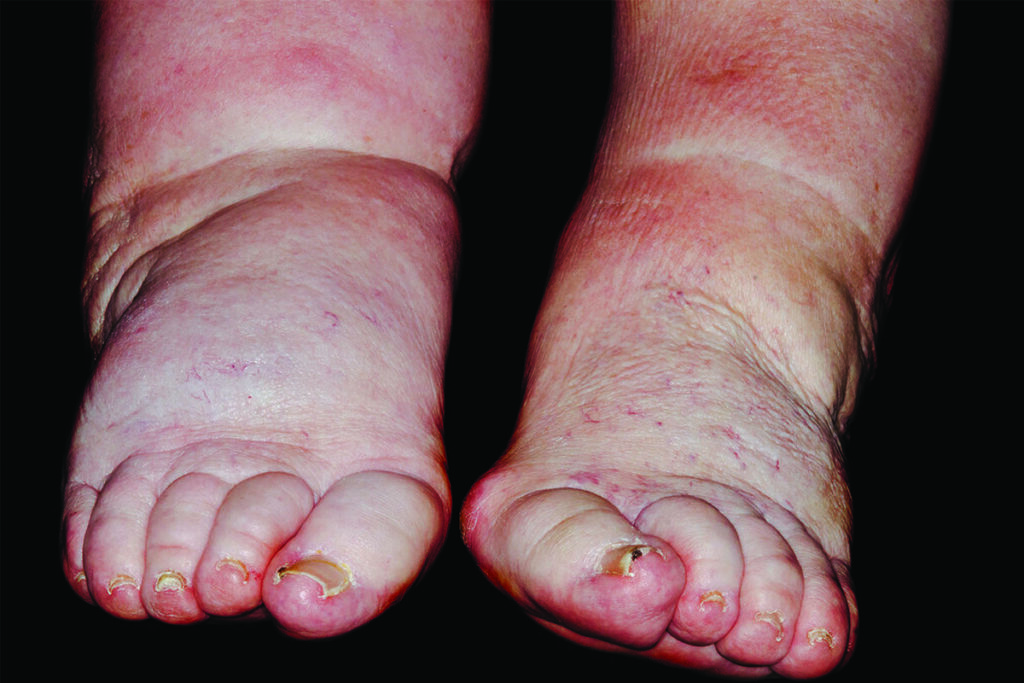Clinical clanger: ‘My ankles are really swollen, doctor – can you give me some of those water tablets?’

Continuing our series on clinical scenarios that can be mishandled in primary care, Dr Peter Bagshaw explains the potential for inappropriate use of diuretics in ankle oedema
You see an 82-year-old widow in surgery. She has had swollen ankles for several months and requests ‘water tablets’ for them, as it is becoming difficult for her to put on shoes. Her mobility is limited by hip osteoarthritis, but she has no breathlessness or other symptoms, and no evidence of local infection, cardiac problems or other disease; you note she is overweight and confirm bilateral pitting oedema.
The reality
Ankle oedema in this age group is common and is usually due to immobility. Differential diagnosis includes cardiac failure, cirrhosis, renal disease, venous insufficiency, lymphatic system disease and protein deficiency. It can also be iatrogenic; calcium channel blockers commonly give swollen ankles, but so too can steroids, oestrogen, pioglitazone, gabapentin, pramipexole and NSAIDs.1 In most cases, diuretics will not help.2
The issue
Swollen ankles are often treated empirically in older people, sometimes after excluding heart failure, often without investigation. However, diuretics are not benign drugs. They are the commonest cause of side-effects in older people, including weakness, confusion, postural dizziness, falls and fits.3 Around 20% of people taking them develop hyponatraemia and 5% develop hypokalaemia.3 Weight loss, exercise and elevation of legs, and use of compression stockings in venous insufficiency are much more effective, but harder to achieve.
The evidence
Effective treatment depends on knowing the cause. In chronic venous insufficiency, diuretics are inappropriate, with elevation and compression the effective treatments. In medication-induced swelling, diuretics are not effective and in lymphoedema they are rarely effective long term.2 For the former, reducing or stopping the medication is the only answer, while lymphoedema is best addressed by compression bandaging, good skin care, exercises and manual lymphatic drainage.
One study found a fifth of over-65s were on diuretics.3 This is often without a clear indication, and with significant risk of harm.The adverse effects of these drugs are often overlooked, and investigation for other causes is often not done.4
Avoiding a clanger
Basic investigations are measurement of BNP, FBC, and renal and liver function. If swelling is unilateral, the differential diagnosis alters: it is important to exclude a DVT, and I have seen it as a presentation of cancer, restricting lymphatic drainage. As Bunden comments, ‘the pathologic process, not the oedema is the diagnosis’.5 Drug-induced oedema is often apparent from the history, while lymphoedema is non-pitting, unlike the pitting oedema of venous insufficiency or cardiac failure.
Caveats
There are occasions when diuretics are indicated – specifically, heart failure, although this should trigger other actions such as an echocardiogram and the addition of an ACE inhibitor and (cautiously) a low-dose ß-blocker.
There are also rare scenarios, such as when a very elderly, immobile patient has horrendously swollen, sometimes leaking legs, where a short course of a diuretic might trigger improvement and the application of other treatments. This requires clear documentation to avoid defaulting to repeat prescriptions.
Key points
- ‘Leg swelling’, ‘oedema’ or ‘pitting oedema’ are descriptions, not diagnoses
- A few basic tests are worthwhile to find the cause of the swelling
- The commonest cause is dependant oedema, not heart failure
- In dependant oedema (and drug-induced oedema and lymphoedema) diuretics will not help
- A fifth of over-65s may be on diuretics, often without a clear indication, and at significant risk of harm
References
- Mayo Clinic. Edema.
- O’Brien J, Chennubhotla S, Chennubhotla R. Treatment of edema. Am Fam Physician 2005;71:2111-7 Link
- MacClennan W. Diuretics in the elderly: how safe? BMJ 1988; 296:1551-2 Link
- Thaler H , Wirnsberger G, Pienaar S et al. Bilateral leg edema in the elderly. Clinical considerations and treatment options. Eur Geriatr Med 2010;1:353-7 Link
- Bunden W. The chronically swollen leg: finding the cause. In Venous Ulcers. Bergen J, Shortell C (eds). Elsevier Academic Press 2006
Pulse October survey
Take our July 2025 survey to potentially win £1.000 worth of tokens

Visit Pulse Reference for details on 140 symptoms, including easily searchable symptoms and categories, offering you a free platform to check symptoms and receive potential diagnoses during consultations.
Related Articles
READERS' COMMENTS [5]
Please note, only GPs are permitted to add comments to articles











The other indication for diuretics is, despite explanation as above, the patient would still like to try a diuretic. We have quite enough unhelpful officious oafs in the public sector happy to say “no” at every opportunity already thanks.
I found they worked well, and the punters were grateful. In this scenario: say “no” and wait for an ulcer to develop. And/or cellulitis.
20% hyponatraemia? So if the Na is 1mmol down- who cares?
The above comments show the gulf between Academic World vs Real World.
GPs know very well that diuretics are a temporary “cheat” with potential side effects, but (as JG points out) they can significantly reduce the incidence of ulceration and infection.
It’s all very well asking your elderly patients to lose weight, elevate their legs, and wear horribly uncomfortable compression stockings , but in reality they simply don’t comply.
Provided the dose is low, the course is short, and U+Es frequently checked, diuretics are still a useful option, even if the boffins tut-tut at our ignorance and incompetence.
Thanks for this useful write up. I appreciate others comments on the practicalities but it’s a useful reminder given the high frequency consulting we see these days.